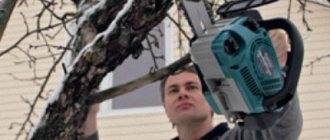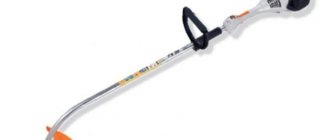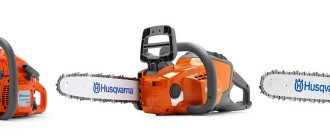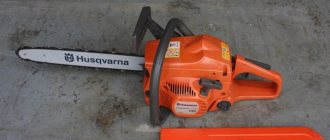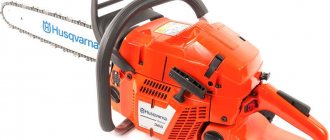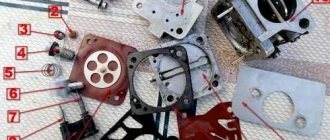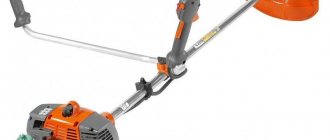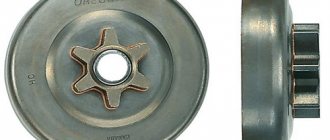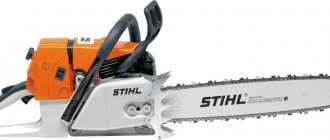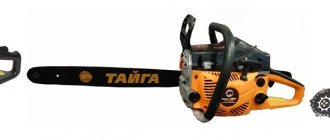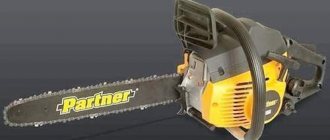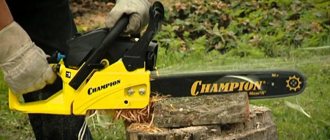The chainsaw market is carefully segmented by manufacturers who try to make it easier for consumers to choose and at the same time not miss out on buyers looking for non-standard solutions. In general, powerful and low-power, compact and massive, household and professional models stand out. At the same time, peripheral chainsaws, which combine several diverse qualities, are also in special demand. These units include the Husqvarna 240 version, endowed with the power of a semi-professional saw and the ergonomics of a household model.
General information about chainsaws
Husqvarna is a well-known brand for those who professionally work with chainsaws, as well as for summer residents and gardeners. There are not many companies around the world that offer equipment of similar quality. Perhaps, only the manufacturer Shtill can compete with this brand. One way or another, the 240 modification is fully consistent with the best ideas about Husqvarna products that have developed over decades. The chainsaw continues the concept of the small household saw 236, but with significant modifications. Firstly, thanks to X-Torq technology, the designers have significantly increased the power potential of the unit. Secondly, changes were made to the optional software, due to which the Husqvarna chainsaw in the new version has become more convenient and safer.
What tasks can this device perform? For the most part, this is work within the framework of a private household - collecting firewood, pruning bushes and trees, clearing a site, etc. But if ordinary models for domestic use perform similar work in small volumes, then the 240 version differs from them in productivity and endurance. That is, for full maintenance of a country household, this chainsaw is optimal.
Specifications
During the development process, the creators paid attention to both the power filling and the structural design. The result is a Husqvarna 240 saw, balanced in its capabilities and options, the characteristics of which confirm its rich working potential:
- Power – 2 l. With.
- Power potential – 1.5 kW.
- The length of the unit tire is maximum 40 cm.
- Number of chain links – 56.
- Groove width – 1.3 mm.
- Engine volume – 38.2 cm3.
- Fuel tank volume – 300 ml.
- Oil tank capacity – 200 ml.
- Noise impact – 113 dB.
- Weight – 4.7 kg.
Maintenance of the Husqvarna chainsaw 240
To ensure a long service life of the chain saw, the owner of the equipment must regularly carry out maintenance work, which boils down to the following:
- refueling with fuel and oil;
- chain sharpening;
- cleaning the instrument from contamination;
- air filter maintenance;
- spark plug maintenance;
- carburetor adjustment;
- checking the condition of the brake system;
- cleaning oil channels;
- sprocket replacement;
- guide maintenance.
New equipment owners ask the following questions:
- how to remove the carburetor from a Husqvarna 240 chainsaw;
- How to adjust the carburetor on a Husqvarna 240 chainsaw yourself.
Carburetor adjustment
After break-in, some chainsaw owners adjust the carburetor. It consists of several stages:
- Start the saw and turn the high and low speed adjustment screws until they stop. Unscrew it back 1.5 turns;
- Warm up the saw for about 10 minutes. Set the idle speed using the idle speed screw. With the correct settings, the chain will not move along the bar at idle;
- Check the saw for acceleration. When you press the accelerator, the speed should increase quickly.
We invite you to watch a video that shows how to disassemble and reassemble the Husqvarna 240 chain saw.
The following video shows how to adjust the carburetor of the Husqvarna 240 chainsaw with your own hands.
Technological features
Typically, the development of practical and powerful technology excludes an equally attentive approach to new technologies and functions. Often, the additional option even contradicts the utility of the same chainsaws. But in this case, in order to preserve the idea of an ergonomic home unit, the creators took care of the latest safety systems and solutions that increase the ease of handling of the structure. So, the Husqvarna chainsaw in modification 240 is equipped with a vibration damping system, a side chain tension mechanism, combined throttle control, quick start, etc. From the point of view of increasing productivity, the already mentioned X-Torq system can be highlighted. On the one hand, it minimizes emissions, and on the other, it reduces fuel consumption. And against this background, the overall optimization of engine operation helps to increase power.
Modifications
Husqvarna tries to supplement each successful model with versions provided with some improvements. Since users have conflicting opinions regarding one or another characteristic, sometimes several modifications are born, intended for different consumer categories. In the case of the Husqvarna 240, we can talk about the S and SG versions. The first is less popular and is an optimized option, designed specifically for small-format operations with low resource costs during operation. The SG modification received a redesigned power filling. It did not increase power or performance, but became more reliable and durable. That is, the cutting quality has remained the same, but the wear resistance of the element base has increased.
How to sharpen a chain on a chainsaw with your own hands
A person who has a chainsaw on his farm should know how to sharpen a chainsaw chain with his own hands. There are several ways:
- Sharpen using a file (the most common method of sharpening, since it allows you to sharpen the tool directly at the site of sawing work.)
- Sharpen using a special machine (this method is used in service centers, but can also be used in private households)
- Sharpen using a grinder. Sharpening using this method requires certain skills. A less common method, because It is quite difficult to sharpen correctly using an angle grinder.
In this video, you can familiarize yourself with the sharpening process, the most popular methods and tools used for this.
Husqvarna 240 Operating Instructions
Each time before using the saw, you should check the integrity of its structural parts. Particular attention is paid to the condition of the chain, brake mechanism and handles. Then you can turn on the engine. This is done through the handle of the cable leading to the starter. It should be pulled, keeping the unit firmly pressed to the ground. In this case, you cannot wind the cable around the handle. The work process can be performed at full power output, slowing down after completing the sawing session.
It is also important to monitor the fixation of the Husqvarna 240 structure. The instructions note that both left-handers and right-handers must hold the unit with both hands so that the right hand is at the most critical point of retention - on the rear handle. Accordingly, the left hand should be responsible for gripping the front handle. After finishing the work, you must press the “Stop” button, lower the unit to the ground and begin inspecting it and, if necessary, disassembling it. Next, it is imperative to clean the functional parts, and proceed to subsequent work with renewed oil.
Husqvarna Chain Sharpening Angle
Content
Chainsaw chain sharpening angle. How to choose the right one?
Even the popular Stihl does not last forever: eventually the teeth of the chainsaw wear out, which is easy to adjust according to the liking of the resulting chips. With a dull cutting edge, the chips come out small, since the working edge does not cut, but crushes the wood. Naturally, the effort expended by the operator increases sharply. It's time to sharpen the saw. How to do this correctly - choose the best technology, establish what angle of tooth sharpening should be and how to check it?
External signs of a dull cutting edge of a chainsaw tooth
Let us recall that a chainsaw tooth has a complex configuration (see Fig. 1), which also depends on the direction of movement of the chain. It has two working edges: a side edge, which is located perpendicular to the axis of movement of the links, and an upper edge, located at a certain angle to the direction of movement of the chain. In addition, each tooth has a limiter, the characteristics of which determine the height of the chips removed. Since the main cutting force falls specifically on the working angle, all subsequent work with equipment will depend on what angle to sharpen the tooth.
Sketch 1 – Multifunctional parts of a chainsaw tooth and their appearance
Before long-term work with a chainsaw, it needs to be inspected and test sawed, as a result of which:
- Visually establish the presence (or absence) of a conical section adjacent to the corner of the tooth, as well as a radius rounding on it - the main signs of blunting (see Fig. 2).
- Check the feed force at which the tool operates stably and quickly produces a cut. For sharp teeth, the initial moment of tooth penetration into wood occurs rapidly, and without significant resistance to the material.
- Find out if there are vibrations of the chain during a steady cut - if they are tangible, then the teeth need to be sharpened.
- Examine the appearance of the just-cut end (especially if the tool is used for longitudinal sawing). If there are rough chips and dents, the chainsaw chain must be sharpened.
READ Husqvarna 135 Chain How many Links
Sharpening angles and chainsaw tooth configuration
The cutting edge of a tooth is characterized by the following parameters:
In addition, each tool model has its own tooth pitch, the value of which for household and semi-professional models is associated with the power of the chainsaw and the torque that the drive develops. For example, for longitudinal sawing, the pitch is taken smaller (for example, 0.325 inches). In this case, work productivity will decrease, but the required force will be significantly lower. The upper values of steps for household chainsaws are taken very rarely, mainly when felling trees with a large trunk diameter. At the same time, the motor power should not exceed 2500 W.
The thickness of the cutting edge of most chainsaw manufacturers is set to the same, and equal to 1.3 mm (there are also edges with a thickness of 1.1 mm, but, firstly, they are extremely difficult to sharpen at home, and, secondly, such links are extremely have little functionality: they can only be used for cutting thin branches).
The height of the chain profile can be either 0.625 mm or 0.762 mm, and for household power tools, in the vast majority of cases, a specifically small profile is used. When sharpening limiters, this parameter is very important, since as the height of the excess permissible values decreases, the vibration of the tool during operation increases, although the quality of the cut remains satisfactory as before. Therefore, you should not get carried away with lowering the height of the stop when sharpening a tooth.
Saw chain. Sharpening. Circuit parameters. How to make your own device for perfect sharpening.
We have collected the best experience in chain sharpening
and summarized everything in one video. We show a device for completely
Sharpening chain for rip sawing
VKontakte page: Craftsman Forum:
The sharpening angle of a chainsaw chain depends on the main purpose of the tool - for transverse or longitudinal sawing. Since during longitudinal sawing the resistance of wood is always noticeably higher, the edge of the tooth must be very sharp. It is recommended to do it in the range of 6...12° (for comparison - with a predominance of cross cuts - up to 25...30°). Naturally, in the first case, sharpening should be done more often, and especially painstakingly, since the unacceptably small angle of inclination of the tooth contributes to its rapid chipping when the chainsaw is used. This is especially important for links that are made from structural alloy steels containing silicon and manganese, for example, 40ХГС or 35ХГСА.
READ Parallel Guide for Saw
Chainsaw chain sharpening template
When purchasing a chainsaw, make sure to acquire a special template (see Fig. 3), with which you can simply set rational values for the tooth angles. With its help, the values of the rear angles of the upper and end blades, as well as the front angle of the edge are controlled (it is indicated in the manufacturer’s annotation, and can vary within 65...80°).
It is especially important to use a template to estimate the clearance angle of the upper blade. This sharpening angle of a chainsaw chain is otherwise very difficult to determine, and yet it must be maintained within rather limited limits - from 50 to 60°.
The sharpening angle is measured by determining the angle between the upper cutting edge and a line perpendicular to the chain guide.
The sharpening angle of the chainsaw chain can be changed, depending on what work will be done. As the hardness of the wood increases, its value should decrease. In general, the optimal angle value is 10...12° for longitudinal cutting, and 25...30° for cross cutting.
Sketch 3 – External appearance of a template for sharpening chainsaw teeth
Sharpening can be done manually, using a round file with a working diameter of 4...5.5 mm, or on a machine. In the first case, it is very important to correctly position the tool relative to the tooth being sharpened. The upper edge of the working part of the ratfil is placed approximately a fifth above the upper edge of the tooth. The tool is positioned perpendicular to the chain axis, and at an angle of 25...30° to the upper edge of the tooth
1 round ratfil is not enough. To sharpen the limiter, you will need a thin file, and to clean the work area, you will need a hook that removes the sawdust that forms. There are also special holders on sale, on which the stripes for the direction of movement of the ratfil relative to the chain axis are graduated. As can be seen from Fig. 4, the holder can be installed on the tooth from above, and rest on its upper edge. Since the height of the holder is adapted to a certain chain pitch, it should be selected in relation to chainsaws of certain models and brands.
READ How to Sawing with a Jigsaw at an Angle 45 Video
A little needed set for obtaining the correct angle for sharpening a chain manually is shown in Fig. 5.
Sketch 5 – Set of sharpening tools and accessories
First, the teeth of one direction are sharpened, and then the other. Start by lightly pressing the tool away from you, gradually increasing the load. During sharpening, the round file is periodically rotated along its axis.
Mechanized sharpening on a machine
Sharpening on a machine is much more comfortable and does not require the highest qualifications of the performer. The sharpening angle of the chainsaw chain can be changed, depending on what work will be done. Such machines are electrically driven and equipped with special grinding wheels.
For a household workshop, it is worth getting small-sized units that do not take up much storage space and are suitable for fast and high-quality sharpening of chainsaw chains from various manufacturers. Such units must operate from a stationary power supply with a voltage of 220 V, have low power consumption (up to 100 W) and be easy to install on the circuit.
When choosing a machine, you need to pay attention to its subsequent technological properties:
- Possibility of processing teeth with different widths of the upper edge and different chain pitches;
- Possibility of adjusting the sharpening angle, within the limits indicated earlier;
- Availability of replaceable grinding discs;
- Constant cut width.
The design of the machine is ordinary, and contains a drive electric motor, a shaft with a seat for a sharpening disk, a handle with controls, and a device for attaching the machine to a chain. Adjustment of the force of pressing on the sharpened element is ensured by a spring clamp. Modern models of sharpening machines are equipped with a differentiated clamp, which ensures self-centering of the product on the machine. For ease of work, there is a measuring scale on the clamp body.
Optionally, the machines can also be equipped with a small electronic light that illuminates the working area, as well as a hydraulic booster that facilitates sharpening.
Safety of work is ensured by a folding safety shield.
Source
Maintenance instructions
Before the first use, the saw must be adjusted. This is done by means of a special T-screw in the carburetor system. With its help, the optimal idle speed is adjusted. In the future, you should regularly check the operation of the brake system. The manufacturer recommends testing it as follows: in operating condition, it is necessary to hold the unit by two handles above the log, then release the front handle so that the working blade falls onto the wood surface. If in free fall the chain stops under the influence of the inertial brake, then you can continue working with the equipment. The most “capricious” spare parts of the Husqvarna 240, including the spark plug, muffler and air filter, should be checked periodically. The frequency of checking depends on the intensity of use of the chainsaw. With frequent use, it is recommended to check every 10-15 hours of direct work.
Preparing the chainsaw for work
Before putting into operation the tool must be properly prepared:
- The chainsaw is assembled into a single structure.
- The headset is mounted and the saw chain is tensioned.
- The saw is fueled with oil and a pre-prepared fuel mixture.
- The tool is launched. as described in the manual.
- The functionality of the braking system is immediately checked.
- Checking the supply of oil to the chain.
- The idle speed is adjusted.
The saw is started, all systems are engaged and working - all that remains is to break in the chainsaw. And the video will tell you how to start the Husqvarna 240 chainsaw correctly.
Run-in
The break-in period lasts about 10 hours. During this period, gas-powered tools are operated in a gentle mode, without increased loads. The purpose of break-in is to grind in all moving parts of the chainsaw. If you skip the break-in and immediately put maximum loads on the chainsaw, the likelihood of the piston jamming increases sharply, which can lead to engine failure.
Positive reviews
The unit as a whole suits most users. It is praised for its high power, the introduction of modern technological solutions, as well as its ease of use. At the same time, the proprietary reliability of the case has been preserved. Although some of the external protection elements are made of plastic, there are practically no complaints about them. Unlike competitive household models with increased performance, in this case we can also note the reliable Husqvarna 240 carburetor, which does not cause problems when setting up. The recommended parameters are set at the factory, but if desired, each user can reconfigure it to suit their needs. By the way, one of the advantages of this carburetor is also the optimized consumption of the fuel mixture. Its regulation allows you to save gasoline costs without reducing the resource power potential.
Owner reviews
Andrey. 33 years
I bought the 240th model back in 2014. The saw is excellent. It started without any problems, and there were no incidents with the run-in either. I use it to take care of the garden; the trimmings are used as fuel for the bathhouse. The tool is lightweight, powerful, and works without interruption. I changed the filters, replaced the starter a year ago, everything works. Happy with the purchase.
Advantages: lightweight, powerful, durable.
Disadvantages: none.
Maxim, 40 years old
I read a lot of boasts about Husqvarna and am perplexed: either I’m in China and everything is bad, or the reviews are disingenuous. The saw starts with great difficulty, when you’ve already lost hope, suddenly the desire to work on it comes... Everything hangs out, there’s play... the chain doesn’t cut a damn thing, everything falls apart, the parts don’t fit, even though they’re original!
Advantages: I didn’t find it, everything was bad.
Disadvantages: falls apart, does not start. the details don't fit.
Veniamin, 46 years old
I use a chainsaw almost every day. My Husqvarna is already 2.5 years old. I make money with its help - I cut firewood for my neighbors, cut branches and trees, and a couple of times I had to demolish buildings with its help. The tool cuts perfectly, starts easily, I noticed that it started to overheat - I replaced the spark arrester and everything got better. The cable, of course, broke, but overall I’m happy with the chainsaw.
Advantages: powerful, lightweight, repairable, convenient.
Disadvantages: none found.
Negative reviews
The model turned out to be successful in many respects, but some unpleasant nuances are found in almost every evaluation category. If we talk about ergonomics, it will be a tight starter cord that will work only after a few attempts to start. As for the physical comfort when sawing, there is also criticism of the inconvenient location of the handles - although this depends on the conditions in which the Husqvarna 240 is used. Reviews about additional stabilization systems are also contradictory. In this part, we can note both complaints about anti-vibration protection and noise reduction.
